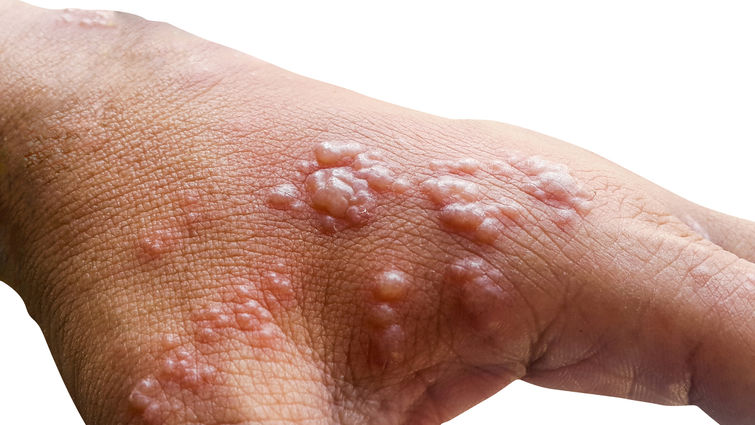 The Centre on Monday have asked ports and airports to ensure strict health screening of all international travellers to contain the spread of monkeypox on the day India reported its second case from Kerala.
The Centre on Monday have asked ports and airports to ensure strict health screening of all international travellers to contain the spread of monkeypox on the day India reported its second case from Kerala.
What is monkeypox?
According to the World Health Organisation (WHO), monkeypox is a viral zoonotic infection caused by the monkeypox virus. It spreads mostly from human contact.
What are the symptoms of monkeypox?
Some of the most common symptoms of monkeypox are muscle aches, headache, fever, low energy, and swollen lymph nodes. "Monkeypox symptoms are like smallpox and chickenpox. At the onset, patients will have fever and enlargement of lymph nodes. After 1-5 days the patient may report rashes on the face, palms or soles. They may have rashes in the cornea leading to blindness", said Dr Piyush Ranjan, Department of Medicine, AIIMS.
The number of rashes leading to lesions can range from one up to several thousand.
Who is at risk of contracting monkeypox?
Those who are in close contact with someone suffering from monkeypox, including sexual contact are at the highest risk. Coming in contact with animals infected with the disease can also transfer the infection.
Are children at risk of getting monkeypox?
Dr Ranjan reveals "the infectivity of monkeypox is less but it can be fatal in children. The COVID-19 infection has more transmissibility, but monkeypox infection occurs after prolonged exposure to an infected person. So the infection rate is very high in COVID and an infected person can infect many. But, monkeypox is less contagious."
How does monkeypox spread?
Monkeypox can spread from person to person contact and also from animal to person contact. In the case of humans, coming through face-to-face, skin-to-skin, mouth-to-mouth or mouth-to-skin contact, with another infected person can lead to monkeypox. Animal hosts include rodents and primates. In addition, Dr Ranjan says that "This virus is also transmitted to humans by coming in contact with a dead animal infected with this virus."
How can I protect myself and others against monkeypox?
The necessary precautions that are to be taken to reduce the risk of monkeypox are:
a) Limiting close contact with people who are either suspected or confirmed of having monkeypox or limiting contact with animals who are infected
b) Cleaning and disinfecting contaminated environment and surroundings
c) Seeking medical attention immediately after noticing any symptoms or getting rashes
The government of India has also issued guidelines regarding the monkeypox disease. The guidelines stress the "surveillance and rapid identification of new cases as the key public health measures for outbreak containment, mandating the need to reduce the risk of human-to-human transmission. It explains the Infection Prevention and Control (IPC) measures, IPC at home, patient isolation and ambulance transfer strategies, additional precautions that need to be taken care of and duration of isolation procedures."
In addition, "contacts should be monitored at least daily for the onset of signs/symptoms for a period of 21 days (as per case definition) from the last contact with a patient or their contaminated materials during the infectious period.
The government guideline also urges people to "raise awareness and educate people about the measures for monkeypox virus", like avoiding contact with any material of the sick person, isolation of the infected patient from others, practising good hand hygiene and using appropriate personal protective equipment (PPE) when caring for patients.

 🕑 28 Oct, 2025 04:46 PM
🕑 28 Oct, 2025 04:46 PM
8th Pay Commission constituted. ToR Approved, Effectively Jan 2026
 🕑 02 Jul, 2025 10:03 AM
🕑 02 Jul, 2025 10:03 AM
Commutation Relief In Sight? Panel Likely To Review 15-Year Deduction Rule
 🕑 12 Jun, 2025 08:12 AM
🕑 12 Jun, 2025 08:12 AM
8th Pay Commission: Uncertainty Looms as Employees Await Terms of Reference
 🕑 24 Apr, 2025 10:21 PM
🕑 24 Apr, 2025 10:21 PM
Staff Side constitutes panel for drafting memorandum to 8th CPC when formed
 🕑 24 Apr, 2025 10:17 PM
🕑 24 Apr, 2025 10:17 PM
8th Pay Commission likely to be set up by mid May
 🕑 09 Apr, 2025 10:27 AM
🕑 09 Apr, 2025 10:27 AM
Loan EMIs to get Cheaper as RBI cuts Repo Rate sgain | See the benefit
 🕑 09 Jun, 2025 08:25 AM
🕑 09 Jun, 2025 08:25 AM
📢 UPS vs NPS: The Retirement Dilemma Facing 27 Lakh Government Employees
 🕑 04 Apr, 2025 04:46 PM
🕑 04 Apr, 2025 04:46 PM
NPS To UPS Switch from April 1: A Detailed Look at the Option to Switch
 🕑 30 Mar, 2025 11:01 AM
🕑 30 Mar, 2025 11:01 AM
8th Pay Commission implementation may get delayed till 2027 – Here’s why
 🕑 27 Mar, 2025 10:25 PM
🕑 27 Mar, 2025 10:25 PM
7th CPC wanted a permanent pay panel, end DA revision twice
 🕑 27 Mar, 2025 08:43 AM
🕑 27 Mar, 2025 08:43 AM
8th Pay Commission: What Kind Of Salary Hike Can Be Staff Expected?
 🕑 20 Mar, 2025 08:24 AM
🕑 20 Mar, 2025 08:24 AM
Why the commuted pension is restored after 15 years, not 12 years
 🕑 17 Mar, 2025 08:37 AM
🕑 17 Mar, 2025 08:37 AM
📈 Expected Dearness Allowance (DA) from January 2026 Calculator